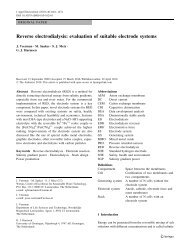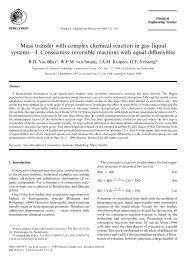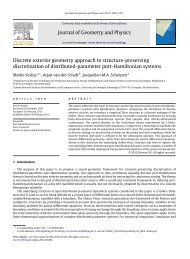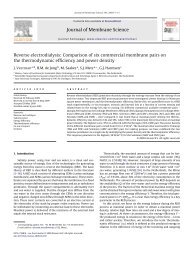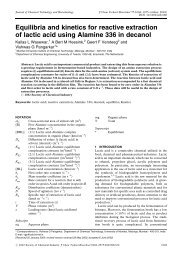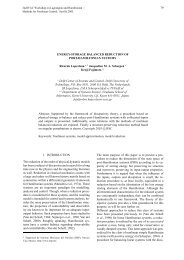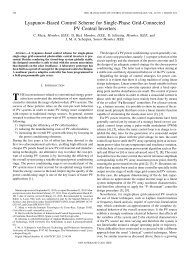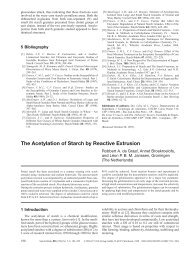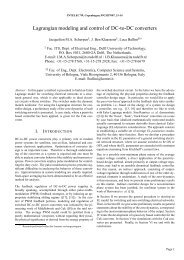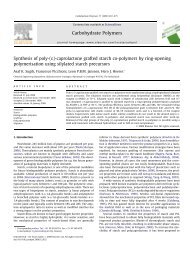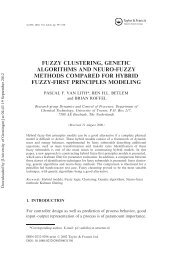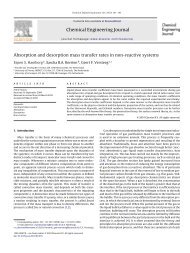MODELLING TOLUENE OXIDATION Incorporation of Mass ... - ITM
MODELLING TOLUENE OXIDATION Incorporation of Mass ... - ITM
MODELLING TOLUENE OXIDATION Incorporation of Mass ... - ITM
You also want an ePaper? Increase the reach of your titles
YUMPU automatically turns print PDFs into web optimized ePapers that Google loves.
188 HOORN et al.<br />
Figure 1. Basic scheme for the kinetics.<br />
known to inhibit the oxidation (Morimoto and Ogata, 1967)<br />
making the operation <strong>of</strong> a continuous tank reactor more<br />
difficult than it is already. A correlation between R 1 and<br />
R 2 was made on basis <strong>of</strong> the observation that in the<br />
oxidation mechanism the primary termination reaction<br />
takes place between two alkoxy radicals (Russell, 1957;<br />
Kondratiev, 1969) whereby alcohol and aldehyde are<br />
formed in a 1 : 1 ratio. For this reason, the parameters k 1<br />
and k 2 were replaced by a single parameter k 12 giving the<br />
following expressions for the reaction rates:<br />
R 1 ¼ k 12 c TOL c O2 (1)<br />
R 2 ¼ k 12 c TOL c O2 (2)<br />
R 3 ¼ k 3 c BALD c O2 (3)<br />
R 4 ¼ k 4 c BALC c O2 (4)<br />
The influence <strong>of</strong> the catalyst was not included in the rate<br />
equations because all experimental data have been performed<br />
at a constant cobalt concentration. The expression<br />
for the Hatta number (w) depends on the reaction rate<br />
equation. For a first-order irreversible reaction with respect<br />
to the absorbing component w is defined by:<br />
pffiffiffiffiffiffiffiffiffi<br />
k D<br />
w ¼<br />
(5)<br />
k L<br />
For systems consisting <strong>of</strong> multiple reactions involving<br />
the gaseous component the most commonly applied simplification<br />
is to evaluate the Hatta number on the assumption<br />
that an overall pseudo zero-order or first-order rate equation<br />
is applicable. The model <strong>of</strong> the xylene oxidation by Cao<br />
et al. (1994) comprises a zero order reaction for oxygen<br />
where Hatta is calculated according to the correlation <strong>of</strong><br />
Hikita and Asai (1964). This approach is also applied by<br />
Suresh et al. (1988) in the modelling <strong>of</strong> the cyclohexane<br />
oxidation. Pohorecki et al. (2001) apply a first order dependence<br />
for oxygen in the cyclohexane oxidation with a<br />
kinetic scheme that has a close resemblance to the toluene<br />
oxidation scheme given in Figure 1. The mass transfer<br />
flux for a first-order irreversible reaction according to<br />
the Danckwerts modification <strong>of</strong> the penetration theory is<br />
defined by (Westerterp et al., 1984):<br />
<br />
<br />
c A,b<br />
J ¼ k L c A,i<br />
1 þ w 2<br />
p<br />
<br />
ffiffiffiffiffiffiffiffiffiffiffiffiffi<br />
1 þ w 2<br />
The extremes for small and large Hatta numbers are<br />
convenient for simple evaluations on basis <strong>of</strong> analytical<br />
solutions.<br />
(6)<br />
w . 2 J ¼ k L c A,i w (7)<br />
w , 0:3 J ¼ k L (c A,i c A,b ) (8)<br />
The enhancement factor is the ratio <strong>of</strong> the flux in presence<br />
<strong>of</strong> reaction [equation (6)] and pure physical mass<br />
transfer under identical conditions [expression is equivalent<br />
to equation (8)].<br />
E ¼<br />
p ffiffiffiffiffiffiffiffiffiffiffiffiffi<br />
1 þ w 2 <br />
c A,i<br />
(c A,b )=(1 þ w 2 ) <br />
c A,i c A,b<br />
(9)<br />
The extremes for small and large Hatta numbers are:<br />
w . 2 E ¼ w (10)<br />
w , 0:3 E ¼ 1 (11)<br />
The Hatta number and the enhancement factor are calculated<br />
from experimental observations, respectively<br />
included in the modelling.<br />
EXPERIMENTS AND OBSERVATIONS<br />
The reactor and auxiliary equipment for the toluene<br />
oxidation experiments are operated in a continuous mode,<br />
Trans IChemE, Part A, Chemical Engineering Research and Design, 2005, 83(A2): 187–195



